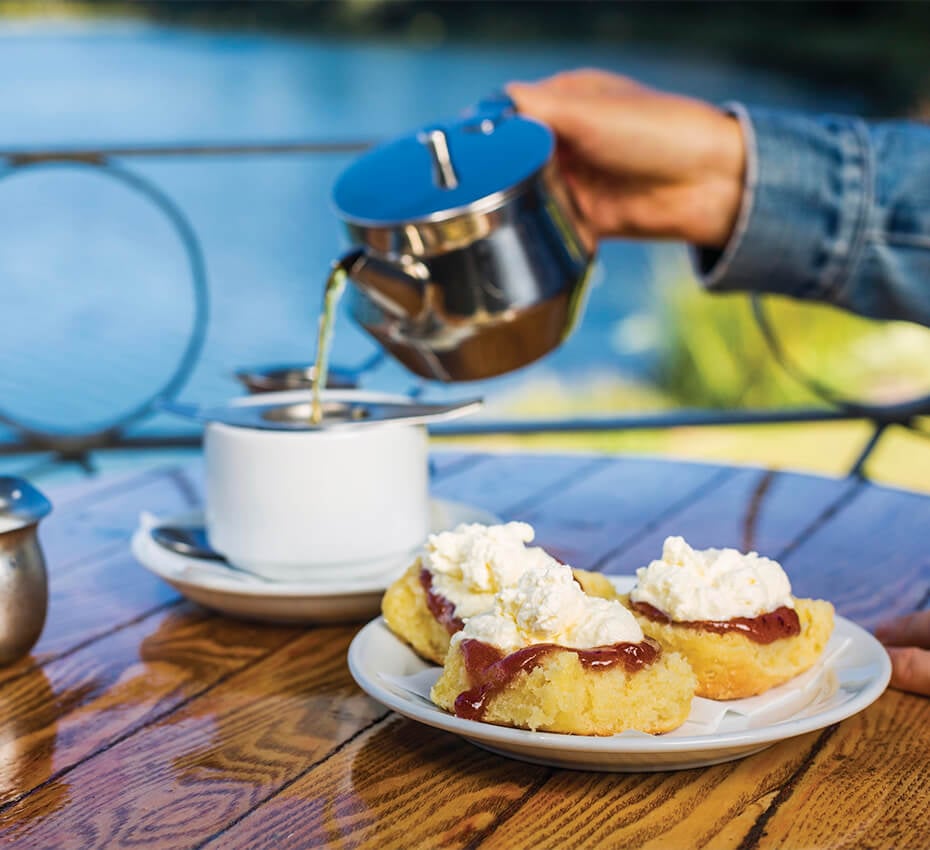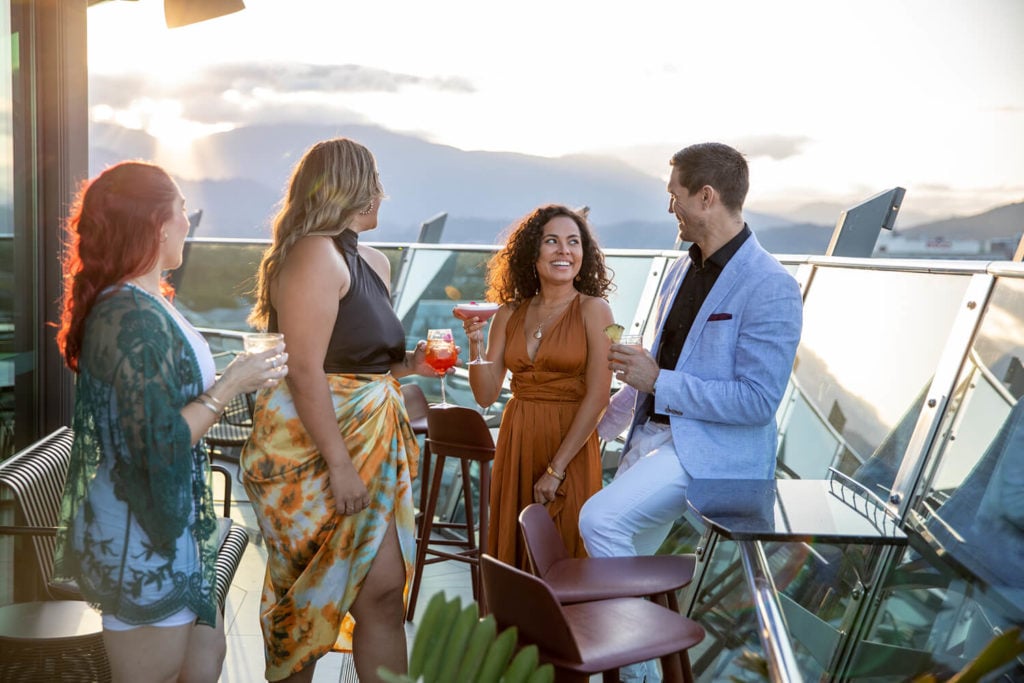TNQ Writer
From earthy bush tucker and exotic fruits to ocean-caught seafood and a biodynamic dairy farm, Tropical North Queensland offers up a menu with a unique ingredients list.
Mud crab
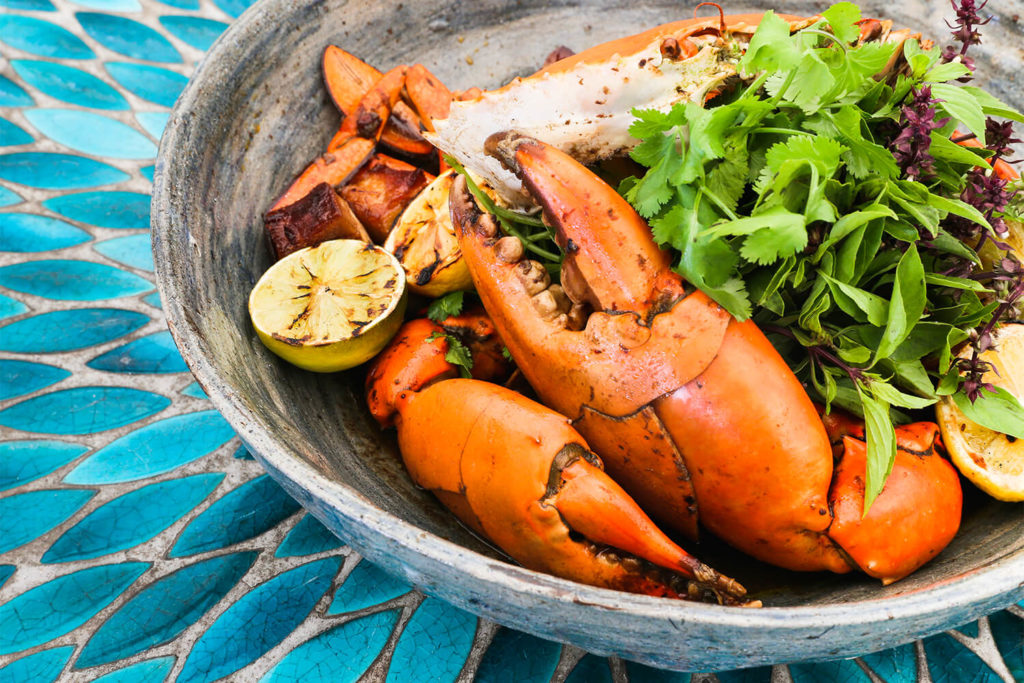
Nu Nu Restaurant, Palm Cove
Nu Nu Restaurant, Palm Cove

The Raw Prawn, Cairns Esplanade
The Raw Prawn, Cairns Esplanade

Get a tour with Walkabout Cultural Adventures & learn about traditional hunting techniques
Get a tour with Walkabout Cultural Adventures & learn about traditional hunting techniques
Shellfish feature at the top end of most good restaurant menus with stand out performers like oysters and lobster. While those may reign supreme in the southern parts of the country, things are a little different in the tropics.
Usually served at market price, a good seafood restaurant in Tropical North Queensland is one with mud crab on the menu. This local delicacy is more elusive than most, burying itself deep burrows within the mangroves of the coastal rivers and estuaries. Leave the preparation and cooking to the professionals and be sure to order mud crab at restaurants like La Cucina or Wrasse & Roe in Port Douglas, Nu Nu Restaurant in Palm Cove or The Raw Prawn, Calypso Club and the Dundees on the Waterfront in Cairns.
If you prefer the thrill of catching your own, jump on a tour with Walkabout Cultural Adventures near Port Douglas to learn traditional hunting techniques of the Kuku Yalanji people or throw a crab pot in the water on a fishing charter from Cairns to Port Douglas.
Chocolate

Cocoa at Charley's Chocolate Factory
Ever dreamt of winning a golden ticket and finally getting to see behind the scenes at a real life chocolate factory? Satisfy your inner child at Australia’s only ‘cocoa tree to chocolate bar’ experience at Charley’s Chocolate Factory in Mission Beach. Here they’ll teach you everything you wanted to know about making chocolate before trying some yourself.
Ready-made bars of chocolate and other speciality products are available at Charley’s but if you devoured your purchase a little too quickly or need to stock up on souvenirs back in Cairns, make a pit stop at Jonsson’s Farm Market, just north of the city.
Redclaw

Chow down on fresh local delicacies at Tarzali Lakes Aquaculture Centre’s Smokehouse Cafe
Redclaw is a species of freshwater crayfish native to Northern Australia and as its name suggests, the male boasts a bright red claw – while the rest of the shell is a deep blue to green colour.
Preferring to call the still waters of local billabongs, lakes and slow-moving streams home, you’ll need a good dose of patience if you’re hoping to find a redclaw in the bottom of your yabbie pot. Increase your batting average and head to Lake Tinaroo on the Atherton Tablelands where the twists and turns of the woody shallows are brimming with the freshwater crayfish, best cooked over a campfire.
If they’re just not biting, don’t worry; make a pit stop at the Australian Platypus Park at Tarzali Lakes on the Tablelands where redclaw feature on their Smokehouse Cafe menu.
Davidson Plum

Get your hands on some Davidson Plums (round dark fruit)
This native Australian fruit pips blueberries off its antioxidant pedestal and while variations exist in other states, it’s the Queensland Davidson Plum – also called Ooray by some Indigenous groups – that’s sought after in the tropics.
Endemic to the Wet Tropics Rainforest of North Queensland, orchids of Davidson Plum thrive in the tropical highlands of the Atherton Tablelands. Amongst these fertile farmlands, you’ll find Rainforest Bounty, a locally owned farm using alternative farming practices that simultaneously restore the landscape for native wildlife, including the threatened Southern Cassowary. While you can only visit once a month, their products are available in many local stockists throughout Tropical North Queensland.
Producing delicious sweet and savoury condiments like the Ooray Plum Jeowbong and Ooray Plum and Blueberry Conserve, Rainforest Bounty products are available online at local stocklists like Jonsson’s Farm Market in Cairns and The Humpy in Tolga on the Atherton Tablelands.
Cleverly weaving native bush fruits into a modern Australian menu is no easy task but Ochre Restaurant in Cairns has it mastered. With menu items like Emu Wontons and Davidson Plum Chilli Sauce or Wattle Seed Pavlova served with Davidson Plum Sorbet, It’s no wonder that getting a seat at this waterfront institution is on the must-do list of many who visit Cairns.
Fruit, fruit & more fruit

Tropical North Queensland has an abundance of native and exotic fruits
With warm weather comes an abundance of tropical fruits. A wander through any of the local markets like Rusty’s Markets or Jonsson’s Farm Markets will afford you not only the weird and wonderful fruits you’ve never heard of, but also many of your favourite exotic fruits for a fraction of the supermarket prices.
Find the largest tree-grown fruit in the world, the jackfruit, which can way up to 50kg and can be eaten as both dessert and a meat-substitute; the sweet and tangy lychee, a perfect summer snack or cocktail condiment; juicy pineapples with around three million harvested in Mareeba on the Atherton Tablelands per year; and the oh-so-sweet red papayas produced by Skybury, Australia’s largest grower supplying around 50% of all the fruit domestically.
Coffee & Tea

Enjoy a coffee from beans grown right in front of you at Skybury Coffee Plantation
Enjoy a coffee from beans grown right in front of you at Skybury Coffee Plantation

Grab a bag of loose tea leaf from Nucifora Tea Plantation
Grab a bag of loose tea leaf from Nucifora Tea Plantation
Would you like tea or coffee? There’s no need to debate in Tropical North Queensland with plantations of both kinds found on the Atherton Tablelands.
If it’s a good pot of tea you’re chasing, then grab a bag of loose leaf tea from the honesty box at the Nucifora Tea Plantation on the Palmerson Highway, arguably one of the most photographed locations in the region.
Perk up with a strong brew at Skybury Tropical Plantation or Jaques Coffee Plantation, near Mareeba, where the altitude, climate and landscape come together to form picture-perfect growing conditions for Australian Arabica Coffee. You’ll find coffee trees planted alongside sweet red papayas at Skybury, who also produce 50% of all red papaya supplied domestically. Grab a seat at their cafes with Skybury offering a panoramic perspective of the plantation and Jaques set among tropical gardens and coffee trees.
Vanilla

Vanilla pods at Broken Nose Vanilla
Buried in the foothills of Queensland’s highest mountain, thousands of vanilla vines and their plump vanilla pods climb their way along a cyclone-proof picket system sheltered under hundreds of rows of banana plants at Broken Nose Vanilla.
While the plantation itself might not be open to visitors, the luxurious vanilla caviar is removed from the beans and available as an extract, paste, powder, caramelised balsamic, infused honey, sugar, tea or coffee. Order online or in a variety of retailers in Tropical North Queensland and beyond.
Mango

Pick up some mangoes while you're in Tropical North Queensland
Pick up some mangoes while you're in Tropical North Queensland

Rusty's Markets
Rusty's Markets

Mango Shaved Ice at Hayabusa of Kuranda
Mango Shaved Ice at Hayabusa of Kuranda
Mangoes are one of the most cultivated tropical fruits world-over and the areas of Dimbulah and Mareeba on the Atherton Tablelands produce about a quarter of Australia’s fresh mangoes and over half of Queensland’s supply.
While the official harvest usually starts in late October, you’ll notice the first curvy green fruit appearing on mango trees when the average daily temperature creeps towards 30 degrees and the fiery-red poinciana trees start to light up the streets with colour.
Local markets, road side stalls and institutions like Rusty’s Market in Cairns explode with mangoes during the summer months, where it’s not uncommon to pick up a box of 20 for $20.
If your suitcase or boarder security won’t allow you to return home with your cheap stash, saddle up to any good juice bar in North Queensland for a fresh smoothie or enjoy frozen cubes of mango with creamy vanilla ice cream at Hayabusa in the Original Rainforest Markets of Kuranda Village.
Sugar cane

Sugarcane is more than just a pretty picture
Sugarcane is one of Australia’s most important rural industries, worth around $2 billion to the Australian economy and is widely used in both local and international products.
If you’re out and about in Cairns, head over to Rusty’s Market early Friday, Saturday or Sunday morning to avoid the queue at the sugarcane juice stall – you won’t be getting just any ordinary cane juice here though. Grab a patented Lush Crush blended with mint, ginger and lime or go for a more tropical taste with an array of local fruits. Whatever your flavour of choice may be, there’s no doubt that Rusty’s will have you coming back for more soon.
Green ants

The green ant has many uses
The green ant has many uses
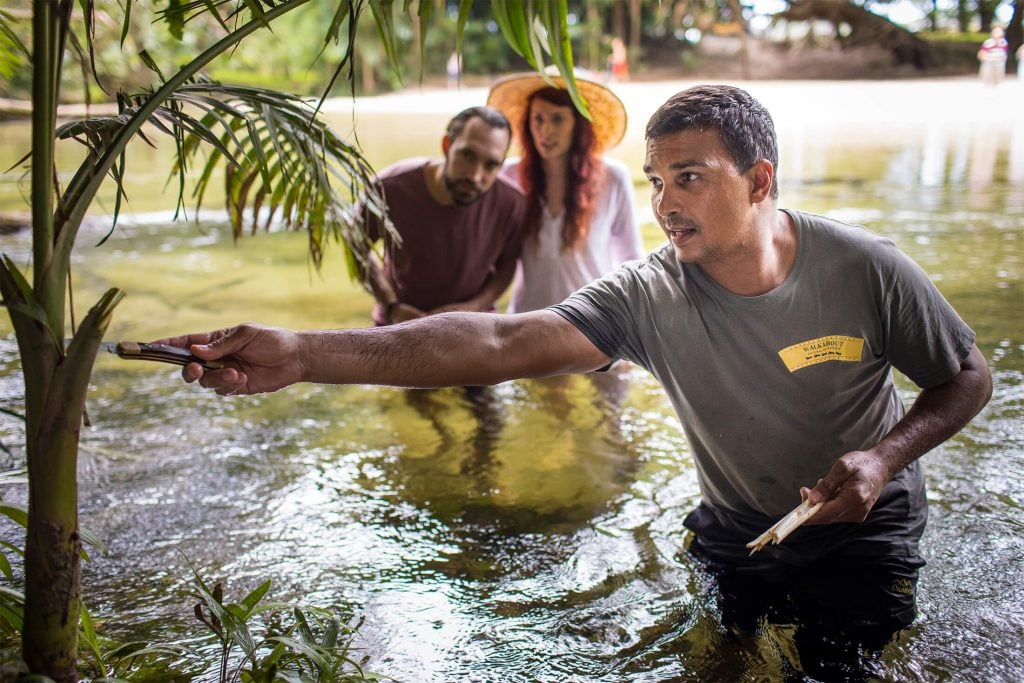
Discover the uses of native plants and fruits with a guided bush walk
Discover the uses of native plants and fruits with a guided bush walk

Sample the diverse Australian Antipasto platter at Ochre Restaurant
Sample the diverse Australian Antipasto platter at Ochre Restaurant
Gaining popularity with native produce innovators, the green ant’s unique tangy flavour puts the humble insect on the world stage. With a flavour reminiscent to lemon or lime, it’s no surprise that the green ant is rich in Vitamin C and was traditionally used by Aboriginal People as a remedy for the common cold, making a tea by dunking the nest in boiling water. They were also used to alleviate the symptoms of fever or they were eaten simply for their flavour as a popular bush tucker.
Now, the tiny creature has been used to create award-winning gins, cheeses and its presence at restaurants has become more widespread. Sample menu items like Salmon Green Ant Gravlax at Ochre Restaurant in Cairns as a part of their diverse Australian Antipasto platter. Take a guided bushwalk through the Daintree with traditional custodians at Mossman Gorge Cultural Centre or Walkabout Cultural Adventures to taste them in the wild and observe their unusual nest structure.
Dairy

Indulge on biodynamic organic cheese at Mungalli Creek Dairy
Indulge on biodynamic organic cheese at Mungalli Creek Dairy

Selection of handcrafted chocolate at Gallo Dairyland
Selection of handcrafted chocolate at Gallo Dairyland

Dairy Cows at Mungalli Creek Dairy
Dairy Cows at Mungalli Creek Dairy
As you traverse the undulating hills of the Atherton Tablelands, specifically the southern parts, you’d be forgiven for thinking the cows were smiling – they probably are – especially at biodynamic farms like Mungalli Creek Dairy.
There are similarities between organic farming practices and that of the biodynamic kind; but the latter definitely ups the ante. Mungalli Creek Dairy’s farm is more than just a place for cows to graze, it’s designed as an ecosystem that is part of the environment rather than separate from it. Unlike conventional farming, which drains the land of life, a biodynamic farm works to restore vitality and rejuvenate the soil, a practice that translates through the cows and into their products – making them taste better!
At the nearby Gallo Dairyland you’ll find a selection of handcrafted chocolate and dairy products straight from the gourmet factory. Gallo Dairyland also offers milking demonstrations that are a real ‘teat’ to watch and an animal nursery for the young (and young at heart).
You’ll find products from Mungalli Creek Dairy and Gallo Dairyland in most major and boutique grocery stores across North Queensland but there’s no better place to taste the smorgasbord of cheeses, yoghurts and milk drinks available than at the dairies themselves. Enjoy expansive views over the rainforest at Mungalli Creek Dairy’s restored farmhouse, or sit back and test out the produce at Gallo’s licensed cafe.
Ice Cream

Try the exotic flavours of Daintree Ice Cream Company
You’ve never tried ice cream like this before! A quick stop in at Daintree Ice Cream Company will see you spooning into black sapote ice cream or roasted wattleseed ice cream, all made with fruit straight from the on-site orchard. With an ever-changing selection of exotic fruity flavours of ice cream, gelato and sorbet, Daintree Ice Cream Company adds a tropical twist to a traditional dessert. If you’ve got some spare time, stick around for a tour of the orchard and see where your favourite flavours began.
Just after you cross the Daintree River ferry keep an eye out for the blue sign with an angel on it. Follow it and you’ll find yourself at Floravilla Icecream – a biodynamic ice-creamery that brags exotic tropical fruits and flavours combined with traditional ice cream making techniques. Try their signature ice cream – “The Daintree” for a taste of local.
Both Daintree Ice Cream Company and Floravilla Icecreams use only the finest local organic dairy products sourced from the pristine farms of Mungalli Creek Dairy.
Beef

Get beef from the paddock to your plate at any of the Crystalbrook Collection Resorts
Get beef from the paddock to your plate at any of the Crystalbrook Collection Resorts

Kur Cow BBQ
Kur Cow BBQ
While the coastline of the tropics is home to seafood and exotic fruits, you’ll find pastoral giants and cattle stations in outback regions like Cape York and the Gulf Savannah.
New kid on the block, Crystalbrook Pastoral takes the term ‘paddock to plate’ to a whole new level. The namesake property of the Crystalbrook Collection, which also includes three hotels, a superyacht marina and a luxury yacht, is at home in the outback of Tropical North Queensland. Over 4,000 head of Brangus cattle, a cross between an Angus and a Brahman, graze on pastures across three stations where superior breeding practices ensure their beef is considered some of the finest in Australia.
Dine at any of the restaurants at Crystalbrook Collection Resorts: Riley, Bailey or Flynn and try the signature beef dishes, bred from Crystalbrook Station and delivered to your fork.
Get up close and personal with Kur-Cow Barnwell Farm, a working cattle station set on 626 hectares near Kuranda, on the Atherton Tablelands.
Barramundi
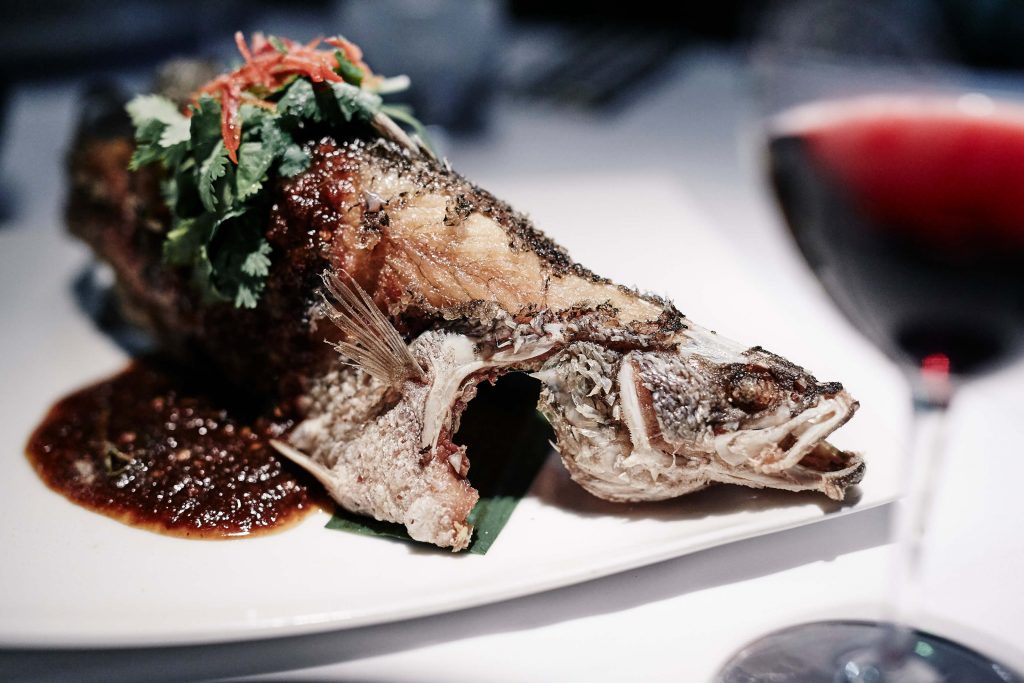
Whole Crispy Baby Barramundi at Tamarind
If there was an official fish of Tropical North Queensland, the ‘barra’ would win the title. Only found in northern Australia, it’s the country’s premier sportfish and one of the most delicious to eat so you’ll be happy to know that it’s served as “fish of the day” on the majority of menus at restaurants, cafes and takeaways.
Barramundi fishing season is open from February to October but you can fish all year round at Hook-A-Barra in the Daintree – a great place for a family day-trip from Port Douglas. If you prefer to bag-a-barra in the wild then book a seat in the boat on one of the region’s fishing charters, Cairns Reef Fishing.
You’ll find barramundi on many menus throughout the region so if you’d prefer to just eat, rather than catch, you’ll find your options endless. Tamarind at The Reef Hotel Casino is famous for its Whole Crispy Baby Barramundi that will melt in your mouth.
Avocado

Stock up and sample fresh local goods including the locally grown Avocados
Of the 77,000+ tonnes of Avocados produces in Australia each year (and rising), over 20,500 tonnes were grown and packed in Tropical North Queensland, so it’s one of the few places in Australia where you don’t have to forgo your house deposit to indulge in a bit of smashed avo.
Locally, the Hass and Sheppard reign supreme and producers like Blue Sky Produce in Mareeba on the Atherton Tablelands ensure local shelves are stocked to the brim before shipping their product throughout Australia.
A foodie reconnaissance of the Atherton Tablelands isn’t complete without a quick stop at The Humpy. Stock up and sample fresh local goods including the locally grown Avocados, native produce, exotic fruits and hot roasted nuts. Sauces, jams and marinades from across the region line the walls, enticing you to purchase extra luggage allowance on the way home.













